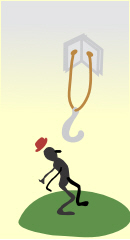|
Number 81 — April 21, 2006
The Art of Story Planning — Part 3
· Previous · INDEX · Next ·
You will remember last week, I wrote that my hero would be a bumbling, inept, crime investigator. I elected, before developing story events, to explore the main character's life and attributes. After getting to know Rolland Royce, I would move on to the supporting cast. I began by examining the reasons for his career choice and if he may have had another option. The basic questions were:
- Why would he go into police work?
- Would he have a natural talent for a different occupation?
I formulated these questions from my childhood experience. First, I was the youngest son. Second, none of my siblings showed any interest in my father's business, making me the target of his hopes. Third, I adored my father, missed his guidance and determined to follow his career path when he died shortly after my seventeenth birthday. The result? I followed his footsteps into an engineering career for which, I discovered some years later, I lacked a natural understanding of mechanics. My native ability should have taken me into teaching. (I hasten to add, I do not feel, nor have I ever felt, any regrets, or bitterness, towards my father for the way my life turned out.) My life experience resulted in these choices I made for Rolland Royce:
- His father is a police officer with the RCMP;
- He has two older sisters, making Rolland the target of his father's ambitions;
- His father teaches his only son about police work, making it appear as an exciting career;
- Rolland relegates his natural artistic talent for drawing to a less important facet of his life.
The events leading into the story involve father teaching his son self-protection; hand-to-hand combat; firearms; tracking; and other skills associated with police work, making it seem like a game rather than a career. When Rolland is a teenager, his father dies in the line of duty. This incident evokes Rolland's determination to follow in his father's footsteps; a rationalization rather than a logical or best choice. Meanwhile, in school his artistic skill improves to a professional level, inducing a family friend to publish it. Despite this success, Rolland sets aside a possible career in the artistic field, considering it an unimportant side interest while devoting his energies to learning police work. Since the RCMP no longer investigate white-collar crime, he sees this field as an opportunity. He graduates from a Canadian University, goes to the London School of Economics in England for postgraduate work in business, and gets training in criminal investigation from Scotland Yard. When he completes his education, he returns to Canada, opens an office as an independent investigator offering security to corporations, and immediately fails. He receives an unexpected inquiry from a large Canadian bank that hires him as a security officer reporting to the president.
Having developed some embryonic idea of where I might go with this tale, I examined two other questions:
- What positive character attributes would he have?
- What character flaws would he have?
The answers I chose for number 1 involved a well-developed work ethic, tenacity, honesty and loyalty. That was the easy part; defining his flaws was more difficult. Eventually, after thinking about Rolland's behavior, I selected a sense of insecurity as his basic character flaw because it is commensurate with his choice of police work over his natural talent. He doubts his own abilities, which causes him to suspect others also see this character defect. His effort to disguise his suspicions evokes overprotection for his family and, in particular, jealousy about his wife's associations. Wow! When I had this idea, a new light shone on the entire concept of my story.
· Previous · INDEX · Next ·
|
